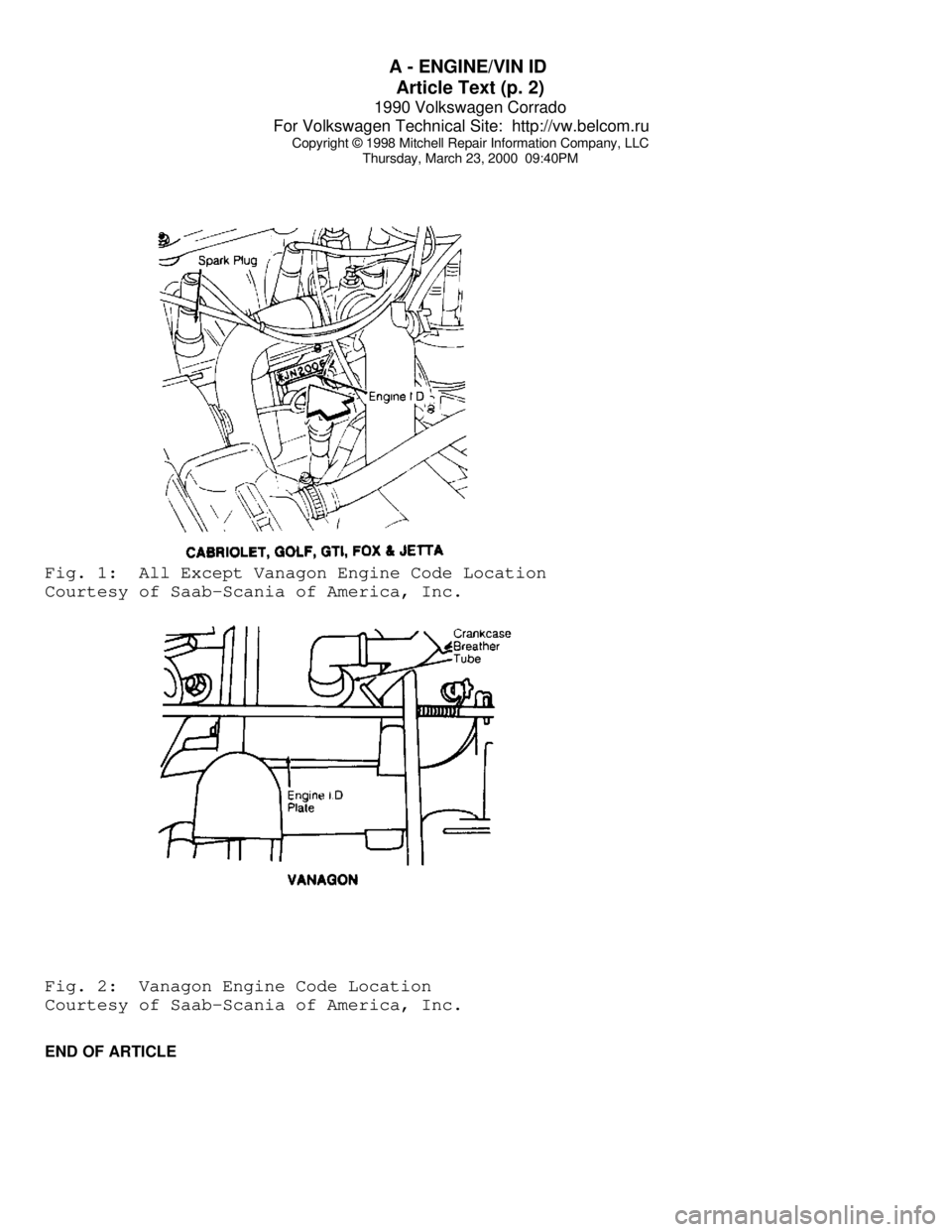1990 VOLKSWAGEN CORRADO engine
[x] Cancel search: enginePage 317 of 906

A - ENGINE/VIN ID
Article Text
1990 Volkswagen Corrado
For Volkswagen Technical Site: http://vw.belcom.ru
Copyright © 1998 Mitchell Repair Information Company, LLC
Thursday, March 23, 2000 09:40PM
ARTICLE BEGINNING
1990 ENGINE PERFORMANCE
Introduction
Volkswagen; Cabriolet, Corrado, Fox, Golf GL/GTI,
Jetta, Vanagon
1990 MODEL COVERAGE TABLEÄÄÄÄÄÄÄÄÄÄÄÄÄÄÄÄÄÄÄÄÄÄÄÄÄÄÄÄÄÄÄÄÄÄÄÄÄÄÄÄÄÄÄÄÄÄÄÄÄÄÄÄÄÄÄÄÄÄÄÄÄÄÄÄÄÄÄÄÄÄ BODY ENGINE FUEL IGNITION
MODEL CODE ENGINE ID SYSTEM SYSTEM
Cabriolet 15 1.8L JH (1) Hall Effect
Corrado 50 1.8L PG (1) Hall Effect
Fox 30 1.8L JN (2) Hall Effect
Golf GL/GTI 17 1.8L 8-Valve GX (1) Hall Effect
Jetta 16 1.8L 8-Valve GX (1) Hall Effect
Jetta GLi 17 2.0L 16-Valve 9A (3) Hall Effect
Vangon 25 2.1L MV (1) Hall Effect
(1) - AFC-Digifant.
(2) - CIS-E.
(3) - CIS-Motronic.
ÄÄÄÄÄÄÄÄÄÄÄÄÄÄÄÄÄÄÄÄÄÄÄÄÄÄÄÄÄÄÄÄÄÄÄÄÄÄÄÄÄÄÄÄÄÄÄÄÄÄÄÄÄÄÄÄÄÄÄÄÄÄÄÄÄÄÄÄÄÄ VIN ID
(VIN) W V W C B 5 1 5 2 L C 0 0 0 0 0 1
1 2 3 4 5 6 7 8 9 10 11 12 13 14 15 16 17
1, 2, 3 - Indicates Nation of Origin.
4 - Indicates Series.
5 - Indicates Engine Type.
6 - Indicates Restraint System.
7, 8 - Indicates Body Code.
9 - Indicates Check Digit.
10 - Indicates Model Year.
11 - Indicates Assembly Plant.
12 thru 17 - Vehicle Production Sequence.
MODEL YEAR VIN CODE APPLICATION
ÄÄÄÄÄÄÄÄÄÄÄÄÄÄÄÄÄÄÄÄÄÄÄÄÄÄÄÄÄÄÄÄÄÄÄÄÄÄÄÄÄVIN Code Model Year
J ................................ 1988
K ................................ 1989
L ................................ 1990
ÄÄÄÄÄÄÄÄÄÄÄÄÄÄÄÄÄÄÄÄÄÄÄÄÄÄÄÄÄÄÄÄÄÄÄÄÄÄÄÄÄ ENGINE CODE LOCATION
Page 318 of 906

A - ENGINE/VIN ID
Article Text (p. 2)
1990 Volkswagen Corrado
For Volkswagen Technical Site: http://vw.belcom.ru
Copyright © 1998 Mitchell Repair Information Company, LLC
Thursday, March 23, 2000 09:40PMFig. 1: All Except Vanagon Engine Code Location
Courtesy of Saab-Scania of America, Inc.Fig. 2: Vanagon Engine Code Location
Courtesy of Saab-Scania of America, Inc.
END OF ARTICLE
Page 319 of 906

A/C COMPRESSOR OIL CHECKING
Article Text
1990 Volkswagen Corrado
For Volkswagen Technical Site: http://vw.belcom.ru
Copyright © 1998 Mitchell Repair Information Company, LLC
Thursday, March 23, 2000 09:41PM
ARTICLE BEGINNING
1990 AIR CONDITIONING & HEAT
Compressor Oil Checking
ISOLATING COMPRESSOR
NOTE: Only compressors with stem-type service valves can be
isolated.
1) Connect service gauge set to the compressor service valves
and open compressor valves slightly (turn in clockwise). Start engine
and operate air conditioning. Slowly turn compressor suction valve
clockwise toward closed (front-seated) position.
2) When suction pressure is reduced to zero or less, turn off
engine and compressor and quickly turn suction valve stem in to full
front-seated position. Suction pressure should be slightly above zero.
Turn discharge valve into front-seated position.
3) To check oil level, slowly open compressor crankcase plug
to relieve any remaining pressure. After oil level is corrected, cap
service gauge ports on both valves. Back-seat suction service valve to
allow refrigerant to enter compressor. Open discharge valve halfway.
4) Loosen discharge service valve cap, allowing refrigerant
pressure to force air out of compressor. Back-seat service valve and
tighten cap. Compressor is now ready for operation.
REFRIGERANT OIL
Only new, pure, moisture-free refrigerant oil should be used
in the air conditioning system. This oil is highly refined and
dehydrated to a point where moisture content is less than 10 parts per
million. The oil container must be tightly closed at all times when
not in use, or moisture will be absorbed into the refrigerant oil from
the air.
SERVICING PRECAUTIONS
NOTE: Recent findings by the EPA indicate that refrigerant is
harmful to the earth's protective Ozone layer. When
discharging refrigerant, DO NOT allow refrigerant to enter
the atmosphere. If available, use refrigerant
recovery/recycle systems when discharging system. Always
follow manufacturer's instructions.
DISCHARGING SYSTEM PRECAUTIONS
If compressor has stem-type service valves, it can be
isolated and removed without discharging entire system. See ISOLATING
COMPRESSOR at the beginning of this article. Otherwise, discharge
system completely before loosening any fittings.
Page 320 of 906

A/C COMPRESSOR OIL CHECKING
Article Text (p. 2)
1990 Volkswagen Corrado
For Volkswagen Technical Site: http://vw.belcom.ru
Copyright © 1998 Mitchell Repair Information Company, LLC
Thursday, March 23, 2000 09:41PM
DISCONNECTING LINES & FITTINGS TEST
After system is discharged, carefully clean area around all
fittings to be opened. Always use 2 wrenches when tightening or
loosening fittings to avoid twisting or distorting lines. Cap or plug
all openings as soon as lines are removed. DO NOT remove caps until
immediately before connections are made. This will keep entry of air
and moisture to a minimum.
CONNECTING LINES AND FITTINGS
A new gasket or "O" ring should be used in all instances when
connecting lines or fittings. Dip "O" ring in new refrigerant oil and
ensure it is not twisted during installation. Always use 2 wrenches to
prevent damage to lines and fittings.
PLACING SYSTEM IN OPERATION
After component service or replacement has been completed and
all connections have been made, evacuate system thoroughly with a
vacuum pump. Charge system with proper amount of refrigerant and
perform a leak test. See REFRIGERANT OIL & R-12 SPECIFICATIONS chart
in this section for system capacities. Be sure to check all fittings
that have been opened. After system has been leak tested, make a
system performance check.
NOTE: Air conditioning systems will not normally need addition of
refrigerant oil unless definite oil loss has occurred due to
ruptured lines, leaking compressor seals, compressor
overhaul or component replacement.
ATSUGI ROTARY VANE DRAIN & REFILL
1) Before checking and adjusting oil level, operate
compressor at engine idling speed, with controls set for maximum
cooling and high blower speed, for 20 to 30 minutes to return oil to
compressor.
2) Stop engine, discharge refrigerant and remove compressor
from vehicle. See SERVICING PRECAUTIONS at beginning of article. Drain
compressor oil from compressor discharge port and measure the amount.
Oil is sometimes hard to drain when compressor is cool. Remove oil
while compressor is warm.
3) If the amount drained is less than 3 ounces, conduct leak
tests at system connections, and if necessary, repair or replace
faulty parts. Check purity of oil and adjust oil level as follows.
4) If amount drained was above 3 ounces, oil level is right.
Pour in same amount as was drained. If amount drained was below 3
ounces, pour in 3 ounces of new refrigerant oil.
Page 321 of 906

A/C COMPRESSOR OIL CHECKING
Article Text (p. 3)
1990 Volkswagen Corrado
For Volkswagen Technical Site: http://vw.belcom.ru
Copyright © 1998 Mitchell Repair Information Company, LLC
Thursday, March 23, 2000 09:41PM
BOSCH 6-CYL DRAIN & REFILL
1) Before checking and adjusting oil level, operate
compressor at engine idling speed, with controls set for maximum
cooling and high blower speed, for 20 to 30 minutes to return oil to
compressor.
2) Stop engine and discharge refrigerant. Remove refrigerant
oil level inspection plug on side of compressor. Oil should be at
lower lip of threaded hole. Add necessary new refrigerant oil (if
low). Replace inspection plug and tighten to 10-12 ft. lbs. (14-16 N.
m).
CALSONIC V5 5-CYLINDER
1) Before checking and adjusting oil level, operate
compressor at 1000-1500 engine RPM, and set controls at maximum
cooling and blowing speed for 20-30 minutes to return oil to
compressor.
2) Stop engine. Discharge refrigerant and remove compressor
from vehicle. See SERVICING PRECAUTIONS at the beginning of this
article. Drain compressor oil from compressor discharge port and
measure oil amount. Oil may be hard to drain if compressor is cool.
Drain oil while compressor is warm.
3) If amount drained is less than 3.2 ounces, conduct leak
tests at system connections. Repair or replace faulty parts as
necessary. Check purity of oil and oil level as follows.
4) If amount drained is more than 3.2 ounces, oil level is
okay; fill with same amount drained using new oil. If amount drained
is less than 3.2 ounces, pour in 3.2 ounces of new refrigerant oil.
DIESEL KIKI ROTARY VANE DRAIN & REFILL
1) Before checking and adjusting oil level, operate
compressor at engine idling speed, with controls set for maximum
cooling and high blower speed, for 20 to 30 minutes to return oil to
compressor.
2) Stop engine, discharge refrigerant and remove compressor
from vehicle. See SERVICING PRECAUTIONS at the beginning of this
article. Drain compressor oil from compressor discharge port and
measure the amount. Oil is sometimes hard to drain when compressor is
cool. Remove oil while compressor is warm.
3) If the amount is less than 2.4 ounces, conduct leak tests
at system connections, and if necessary, repair or replace faulty
parts. Check purity of oil and adjust oil level as follows.
4) If amount drained was above 2.4 ounces, oil level is
right. Pour in same amount as was drained. If amount drained was below
2.4 ounces, pour in 2.4 ounces of new refrigerant oil.
DIESEL KIKI 6-CYL DRAIN & REFILL
1) Before checking and adjusting oil level, operate
Page 322 of 906

A/C COMPRESSOR OIL CHECKING
Article Text (p. 4)
1990 Volkswagen Corrado
For Volkswagen Technical Site: http://vw.belcom.ru
Copyright © 1998 Mitchell Repair Information Company, LLC
Thursday, March 23, 2000 09:41PM
compressor at engine idling speed, with controls set for maximum
cooling and high blower speed, for 20 to 30 minutes to return oil to
compressor.
2) Stop engine, discharge refrigerant and remove compressor
from vehicle. See SERVICING PRECAUTIONS at the beginning of this
article. Remove oil drain plug and drain oil. Measure amount of oil
drained. Install drain plug with new "O" ring.
3) If amount drained was more than 2 ounces (4.4 ounces for
Infinity), refill with same amount of new oil. If amount drained was
less than 2 ounces (4.4 ounces for Infinity), refill with 2 ounces (4.
4 ounces for Infinity). Install filler plug and recharge system.
HARRISON 4-CYL DRAIN & REFILL
NOTE: The Harrison compressor DOES NOT have an oil sump. It's
crucial that the compressor remains well oiled. It takes
very little time to destroy this compressor if it runs dry.
The Harrison 4-cyl compressor is charged (new) with 6 ounces
of refrigerant oil. Because compressor does not have an oil sump, it
should not have to be removed for oil measurement (it retains very
little oil). Note the following situations for checking and adding oil
to this compressor.
NO OIL LEAK; REPLACING COMPONENTS
If only the compressor is to be replaced, remove, drain oil,
measure and reinstall an equal amount of new oil. If evaporator is
being replaced, add 3 ounces of new oil. If condenser is being
replaced, add one ounce.
LOSS OF REFRIGERANT OVER EXTENDED PERIOD
When a loss of refrigerant has occurred over an extended
period of time and a component is being replaced to correct the leak,
add an appropriate amount of refrigerant oil to the component.
SIGNS OF EXCESSIVE OIL LEAKAGE
If system has lost excessive oil, remove accumulator. Drain
and measure oil. If more than 3 ounces is measured, replace the same
amount of new oil as was drained. If less than 3 ounces is measured,
add 3 ounces of new oil. Add and additional 2 ounces of new oil to
compensate for that lost by replacing the accumulator (held in
desiccant).
NOTE: If the exact oil charge is in doubt, drain and flush system.
Add a new 6-ounce charge of refrigerant oil to the system.
HARRISON V5 5-CYLINDER DRAIN & REFILL
1) If system is operable, run for several minutes to
Page 323 of 906

A/C COMPRESSOR OIL CHECKING
Article Text (p. 5)
1990 Volkswagen Corrado
For Volkswagen Technical Site: http://vw.belcom.ru
Copyright © 1998 Mitchell Repair Information Company, LLC
Thursday, March 23, 2000 09:41PM
stabilize system before performing repairs. Turn off engine. Discharge
system and remove compressor. See SERVICING PRECAUTIONS at the
beginning of this article. Remove drain plug. Drain and measure oil.
2) If more than one ounce is drained, add same amount. If
less than one ounce is drained, add 2 ounces of new refrigerant oil to
compressor.
3) If A/C components are replaced, add refrigerant oil to
system. Add one ounce if condenser is replaced. Add 3.5 ounces if
accumulator is replaced.
4) When replacing a component which has caused a large
refrigerant leak, add 3 ounces of new oil plus the required amount for
the part being replaced. Add oil directly to part being replaced if
possible. If oil can not be easily added to part, add oil to
accumulator.
NOTE: If oil drained contains metal chips or other debris, replace
receiver-drier. Flush out system before evacuating and
recharging.
HITACHI 5-CYL DRAIN & REFILL
1) Before checking and adjusting oil level, operate
compressor at 1000-1500 engine RPM, and set controls at maximum
cooling and high blowing speed for about 10 minutes to return oil to
compressor.
2) Stop engine. Discharge refrigerant and remove compressor
from vehicle. See SERVICING PRECAUTIONS at the beginning of this
article. Drain oil from compressor through suction port. Measure
amount of oil drained.
3) If amount drained is more than 2.4 ounces, fill with same
amount using new oil. If amount drained is less than 2.4 ounces, fill
with 2.4 ounces. Install compressor and recharge.
4) If A/C components are replaced. add refrigerant oil to
system. Add 1.7 ounces if condenser is replaced. Add 2.4 ounces if
evaporator is replaced. oil does not need to be added if receiver-
drier is replaced.
HITACHI 6-CYL DRAIN & REFILL
1) Before checking and adjusting oil level, operate
compressor at engine idling speed, with controls set for maximum
cooling and high blower speed, for 10 minutes to return oil to
compressor.
2) Stop engine, discharge refrigerant and remove compressor
from vehicle. See SERVICING PRECAUTIONS at the beginning of this
article. Drain oil from compressor suction port. Measure amount of oil
drained. If amount drained was more than 2.4 ounces, refill with same
amount of new oil. If amount drained was less than 2.4 ounces, refill
with 2.4 ounces. Install compressor and recharge.
MATSUSHITA ROTARY VANE DRAIN & REFILL
Page 324 of 906

A/C COMPRESSOR OIL CHECKING
Article Text (p. 6)
1990 Volkswagen Corrado
For Volkswagen Technical Site: http://vw.belcom.ru
Copyright © 1998 Mitchell Repair Information Company, LLC
Thursday, March 23, 2000 09:41PM
Discharge system. Remove compressor from vehicle. Drain oil
from compressor through inlet and outlet holes. Refill compressor with
3.4-4.7 ounces of oil through suction port. When replacing evaporator,
add 2 ounces. When replacing other A/C components, add 1.4 ounces per
component replaced.
NIPPONDENSO ROTARY VANE DRAIN & REFILL
1) Before checking and adjusting oil level, operate
compressor at engine idle speed, and set controls at maximum cooling
and high blowing speed for 20-30 minutes to return oil to compressor.
2) Stop engine. Discharge refrigerant and remove compressor
from vehicle. See SERVICING PRECAUTIONS at the beginning of this
article. Drain compressor oil through compressor intake and discharge
ports. Measure amount drained. Oil may be hard to drain if compressor
cool. Drain compressor while compressor is warm.
3) If amount drained is less than 2.4 ounces, conduct leak
tests at system connections. If necessary, repair or replace faulty
parts. Check purity of oil level and adjust oil level as follows.
4) If amount drained is more than 2.4 ounces, oil level is
okay; fill with same amount drained using new oil. If amount drained
is less than 2.4 ounces, pour 2.4 ounces of new refrigerant oil.
5) When replacing condenser, add one ounce. when replacing
other A/C components, add .33 ounce per container replaced.
NIPPONDENSO 6 & 10-CYL DRAIN & REFILL
When inspecting system for oil loss, look for signs of
leaking (shiny, wet spots on components or underside of hood). If oil
leak is noted or component replacement is required, use the following
procedure as indicated:
NO OIL LEAK
Discharge system and change components as necessary. See
SERVICING PRECAUTIONS at the beginning of this article. Add
refrigerant oil to components as necessary.
OIL LEAK
1) Slowly discharge system. Repair or replace faulty
components. If equipped with a drain plug, remove plug, drain and
discard oil. If not equipped with a drain plug, remove compressor from
vehicle and pour oil out suction and discharge ports.
2) Replace drain plug (if equipped). Add 1.5 ounces of new
refrigerant oil through suction port. Use new gaskets or "O" rings
when replacing suction and discharge lines.
COMPRESSOR FAILURE OR SYSTEM CONTAMINATED
If either situation exists, discharge system and remove